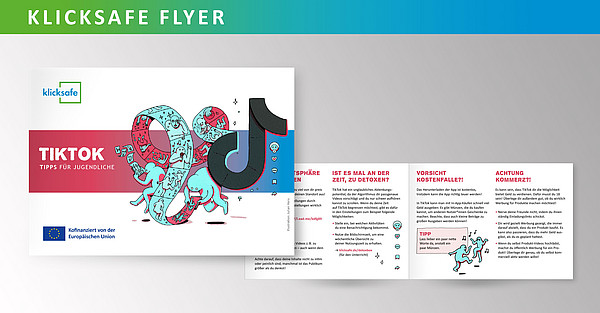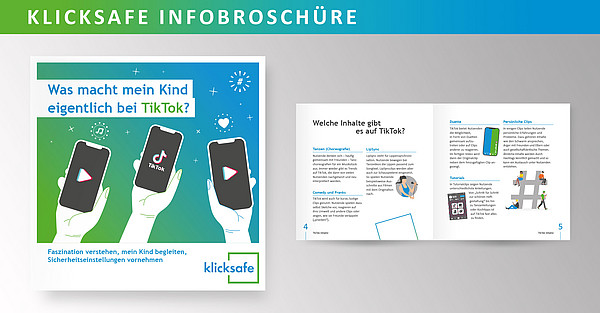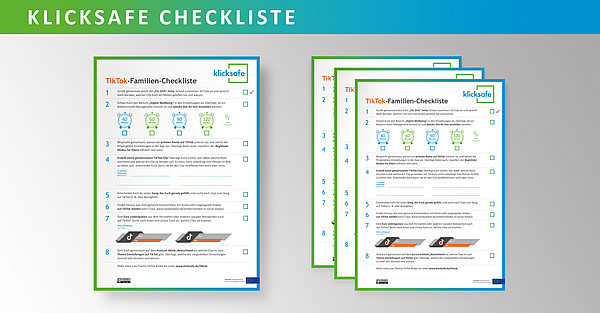TikTok and teenagers
The free app TikTok offers ideal opportunities for entertainment and distraction for many young people. They can spend hours scrolling through the TikToks of friends and strangers or edit and upload videos themselves. Of course, this also poses some risks, such as cyberbullying, hate speech , or cybergrooming. These are especially problematic when very young children use TikTok. Even though TikTok states an age restriction of 13, it is common for younger people to use the app.
It is especially important that you set the app as safely as possible together with your children and talk about possible risks. In this topic, we explain the features and dangers of TikTok use and provide helpful tips.
Age rating and settings
All accounts of young people between 13 and 15 years old areautomatically set to "private" at . This means that users in this age group can decide for themselves who can follow them and who can view or comment on their videos. The comment function under the videos is deactivated in the default settings. This can be changed to "friends" at most. Strangers cannot comment on videos of 13-15 year olds.
The "Duet", "Stitch" and "Suggest your account to others" features are disabled for this age group. Also, videos cannot be downloaded by others. Note: With the help of external programs, other users can bypass this block and continue to save videos.
The accounts of young people between 16 and 17 years are also restricted in some functions. "Duet" and "Stitch" are available, but in the default settings they can only be used with "friends". The downloading of one's own videos by other users is deactivated in the default settings. However, this function can be activated later.
Since November 2022, livestreams can only be started by people over the age of 18 who have at least 1000 followers. In addition, users* can specify before the start whether the stream is suitable for minors. Depending on this, they can then watch the streams.
All of the safety precautions described above only apply if the correct date of birth was entered when registering the account.
- Handysektor: Video tutorial "Set privacy correctly on TikTok".
- Saferinternet.at: Privacy guide TikTok
More control through accompanied mode
Since 2020, TikTok has also offered a so-called "accompanied mode". For this, the account of a parent and the account of a child are linked. The parent account can then make settings for the child's account. For example, it is possible to specify how many minutes a day the child is allowed to use TikTok.
Delete TikTok account
Anyone who no longer wants to use TikTok can delete their own account. To do this, it is not enough to remove the app from the smartphone. In the profile, one can select the option "Delete my account" in the settings. The account is initially deactivated for 30 days and is then permanently deleted. TikTok thus wants to offer the possibility to restore the account once again. A step-by-step guide is available at Saferinternet.at.
Is TikTok dangerous?
TikToks and comments can not only be funny and entertaining, but also inappropriate and harmful to minors. According to research by jugendschutz.net , among other things, right-wing extremist and Islamist content is also disseminated, as well as videos glorifying self-harm .
Young people should always pay close attention to what they reveal about themselves. As pleasing as praise and encouragement can be on TikTok, negative comments can be hurtful.
Prepare your children for this and be sure to show them the most important settings, such as the report and block function of TikTok. Suitable step-by-step instructions can be found at saferinternet.at.
Copyrights
Not only strangers but also TikTok itself can be a danger. Young people often do not know that the videos they create - despite their own creative efforts - are not exclusively their work. Songs that are available on TikTok are only licensed for the TikTok platform. If copyrighted music is used in videos and these videos are further distributed in other services (e.g. Instagram, YouTube), warnings can therefore threaten. As soon as other people are visible in the video, permission must also be obtained from the persons depicted (right to one's own image).
Here it can be helpful to look at the usage guidelines together with your child.
- To the Terms of Use of TikTok
- To the community guidelines of TikTok
- To the security settings at TikToK
Cost trap coins and coins
While downloading and using the TikTok app is free, users* can support their "idols" via money gifts to draw attention to themselves. The coins for the cash gifts are settled with real amounts of money via the app stores, PaySafeCards or the mobile phone bill. The prices here can reach triple digits (as of August 2023). The function to send or receive coins can only be used by persons over 18 years of age. However, the registration process does not check whether the information on the date of birth is truthful. To avoid cost traps, parents should deactivate in-app purchases by making the appropriate settings on the smartphone.



